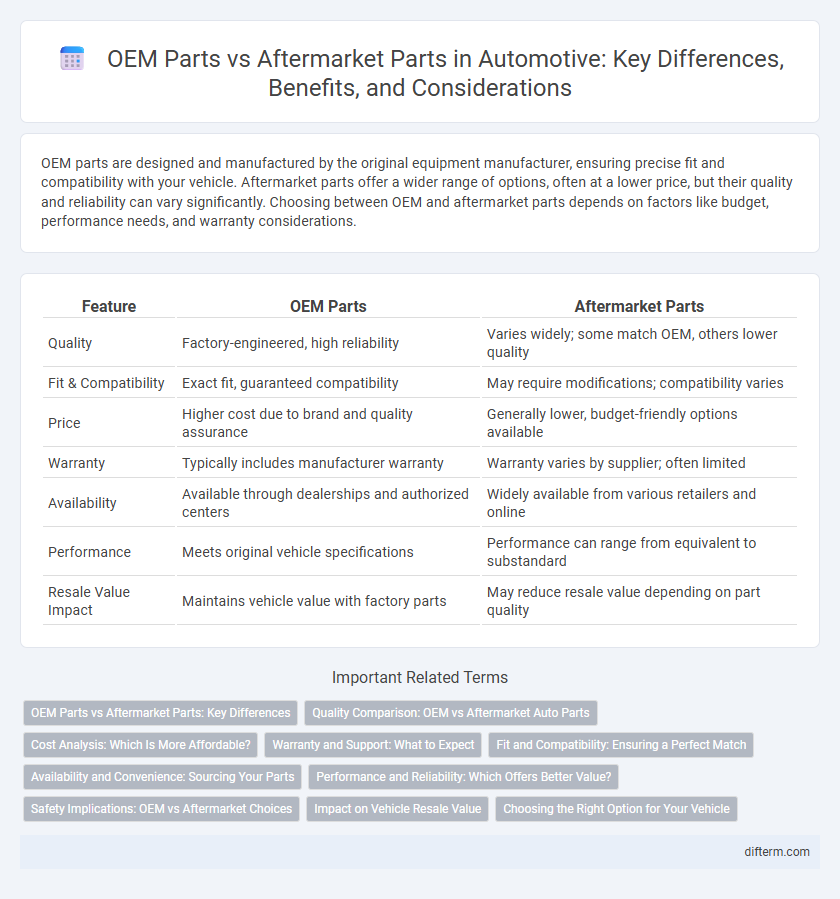OEM parts are designed and manufactured by the original equipment manufacturer, ensuring precise fit and compatibility with your vehicle. Aftermarket parts offer a wider range of options, often at a lower price, but their quality and reliability can vary significantly. Choosing between OEM and aftermarket parts depends on factors like budget, performance needs, and warranty considerations.
Table of Comparison
| Feature | OEM Parts | Aftermarket Parts |
|---|---|---|
| Quality | Factory-engineered, high reliability | Varies widely; some match OEM, others lower quality |
| Fit & Compatibility | Exact fit, guaranteed compatibility | May require modifications; compatibility varies |
| Price | Higher cost due to brand and quality assurance | Generally lower, budget-friendly options available |
| Warranty | Typically includes manufacturer warranty | Warranty varies by supplier; often limited |
| Availability | Available through dealerships and authorized centers | Widely available from various retailers and online |
| Performance | Meets original vehicle specifications | Performance can range from equivalent to substandard |
| Resale Value Impact | Maintains vehicle value with factory parts | May reduce resale value depending on part quality |
OEM Parts vs Aftermarket Parts: Key Differences
OEM parts are manufactured by the original equipment manufacturer specifically for a vehicle, ensuring exact fit, quality, and compatibility with the car's systems. Aftermarket parts are produced by third-party companies and often vary in quality, design, and price, sometimes offering improved features but potentially compromising on fit and warranty coverage. Choosing OEM parts guarantees factory standards and reliability, while aftermarket parts provide a cost-effective alternative with a broader selection for customization.
Quality Comparison: OEM vs Aftermarket Auto Parts
OEM auto parts offer superior reliability and exact fit as they are manufactured by the original vehicle maker, ensuring compatibility with specific models. Aftermarket parts vary widely in quality and may provide cost savings, but inconsistent materials and manufacturing processes can compromise durability and performance. Choosing OEM parts guarantees adherence to factory standards, whereas aftermarket alternatives often require careful scrutiny to avoid substandard components.
Cost Analysis: Which Is More Affordable?
OEM parts typically cost 20-40% more than aftermarket parts due to brand authenticity and guaranteed fitment. Aftermarket parts offer a cost-effective alternative, often priced 30-50% lower, providing flexibility for budget-conscious repairs without compromising basic functionality. Long-term expenses may vary as OEM parts tend to have higher durability and warranty coverage, potentially reducing future replacement costs.
Warranty and Support: What to Expect
OEM parts come with manufacturer-backed warranties that typically cover defects and ensure compatibility, providing peace of mind and reliable performance. Aftermarket parts often offer limited or no warranty, and support may vary greatly depending on the supplier, which can affect long-term reliability and customer service. Choosing OEM parts generally guarantees better warranty coverage and dedicated technical support aligned with the vehicle manufacturer's standards.
Fit and Compatibility: Ensuring a Perfect Match
OEM parts guarantee precise fit and optimal compatibility since they are designed by the original manufacturer to meet specific vehicle specifications. Aftermarket parts can vary significantly in quality and dimensions, sometimes leading to improper installation or performance issues. Choosing OEM parts minimizes the risk of mismatched components, ensuring reliable operation and maintaining vehicle integrity.
Availability and Convenience: Sourcing Your Parts
OEM parts guarantee precise compatibility and are typically available through authorized dealerships, ensuring reliability and authenticity. Aftermarket parts offer broader availability through various retailers and online platforms, often providing faster sourcing options and reduced wait times. Consumers benefit from convenience by choosing aftermarket parts for immediate needs, while OEM parts suit long-term vehicle performance and warranty considerations.
Performance and Reliability: Which Offers Better Value?
OEM parts provide superior performance and reliability due to exact manufacturer specifications and rigorous quality control, ensuring optimal vehicle function and safety. Aftermarket parts vary widely in quality and may offer cost savings but can compromise long-term durability and engine efficiency. Investing in OEM components generally offers better value by reducing repair frequency and maintaining vehicle performance standards.
Safety Implications: OEM vs Aftermarket Choices
Choosing OEM parts ensures adherence to manufacturer safety standards and precise vehicle compatibility, reducing the risk of malfunctions and accidents. Aftermarket parts may vary widely in quality and design, potentially compromising critical safety features like crash performance and component durability. Prioritizing OEM components supports optimal safety outcomes by maintaining the integrity of the vehicle's original engineering and certified testing.
Impact on Vehicle Resale Value
OEM parts maintain vehicle integrity and enhance resale value by ensuring original manufacturer standards and compatibility. Aftermarket parts may reduce resale value due to potential variations in quality, fit, and performance, which can raise concerns for buyers. Choosing OEM components supports long-term vehicle reliability and buyer confidence, positively influencing resale prices.
Choosing the Right Option for Your Vehicle
OEM parts are designed and tested by the original vehicle manufacturer, ensuring precise fit and compatibility with your specific make and model, which often results in better reliability and warranty coverage. Aftermarket parts provide more affordable options and greater variety, but quality and performance can vary significantly depending on the supplier. Evaluating factors such as cost, durability, warranty, and intended vehicle use is essential for selecting the right components that maintain vehicle safety and performance.
OEM parts vs aftermarket parts Infographic

 difterm.com
difterm.com